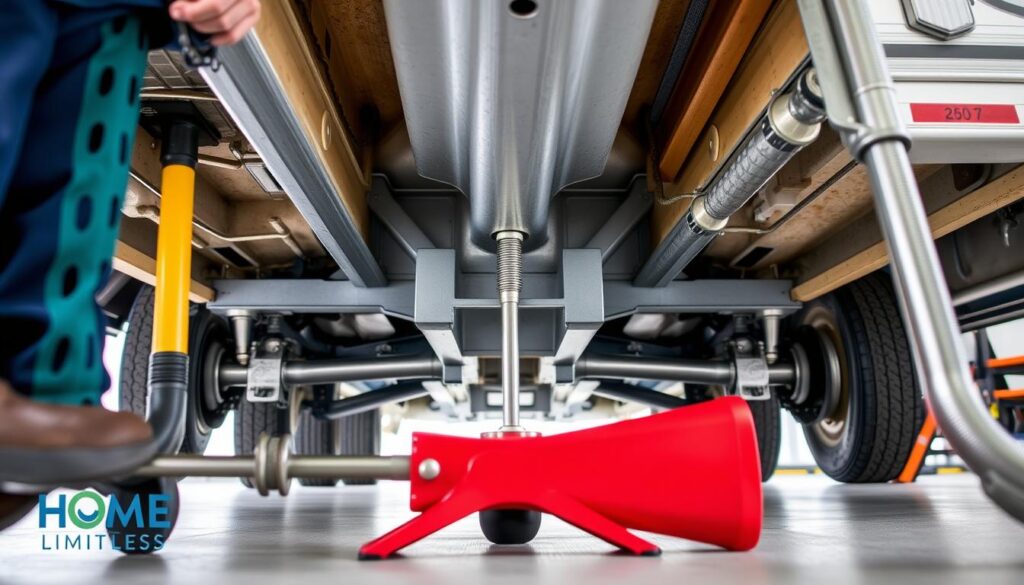Ever thought about replacing your mobile home axles yourself? Many DIY fans are hesitant, thinking it’s too hard. But with the right tools and knowledge, you can save money and learn new skills. This guide will help you check and replace your mobile home axles, making you more confident in maintaining your trailer house.
Mobile home axles are key for supporting your trailer’s weight and moving it. They can wear out or get damaged over time, needing to be replaced. Learning how to replace them yourself can save you money and make you feel proud of your work.
This detailed guide will cover everything from finding the right axles to the steps of removal and installation. We’ll talk about the tools you’ll need, safety tips, and how to pick the best axles. Whether you’re experienced or new to DIY projects, this guide will give you the confidence to replace your trailer house axles on your own.
Table of Contents
Key Takeaways
- Mobile home axle replacement can be a DIY project with proper knowledge and tools
- Safety precautions and proper lifting techniques are crucial during the replacement process
- Identifying the correct axle specifications is essential for a successful replacement
- Different axle sizes have varying load capacities and bolt patterns
- Proper torquing of bolts and lug nuts is critical for safety and performance
- Consulting the owner’s manual or professionals is recommended for specific specifications
- DIY axle replacement can lead to significant cost savings for mobile home owners
Understanding Mobile Home Axles
Mobile home axles are key parts in moving manufactured homes. They ensure safe and efficient transport of large structures.
What are mobile home axles?
Mobile home axle components are the heart of a home’s transport system. They include strong axle beams, hubs, bearings, and brakes. These parts are made to carry heavy loads and move large structures safely.
Common uses and advantages
Trailer axles are not just for mobile homes. DIY fans and construction workers use them for trailers and job site gear. They’re strong, affordable, and come with brakes.
Legal considerations and limitations
Axle rules differ by state and affect mobile home axles. For instance, Michigan’s Motor Vehicle Code has rules for tire types and tread depths. These laws keep roads safe.
| Vehicle Type | Minimum Tread Depth |
|---|---|
| Motorcycles and mopeds | 1/32 inch |
| Passenger cars (under 10,000 lbs) | 2/32 inch |
| Heavy vehicles (over 10,000 lbs) – Front | 4/32 inch |
| Heavy vehicles (over 10,000 lbs) – Rear | 2/32 inch |
While mobile home axles are versatile, they’re not perfect for all uses. Finding parts can be tough, and they’re not made for easy maintenance. Always check local laws before using them for other things.
Identifying Mobile Home Axles
Identifying axles is key when working on mobile homes or trailers. DIY builders often pick mobile home axles because they’re cheap and easy to find. Let’s look at how to spot these axles and what makes them special.
Manufacturer ID Tags
The first thing to do is find the manufacturer tags. These tags are usually stuck to the axle beam. They tell you where the axle came from and its details. If you can’t find a tag, it might mean the axle was made by someone else, so be careful.
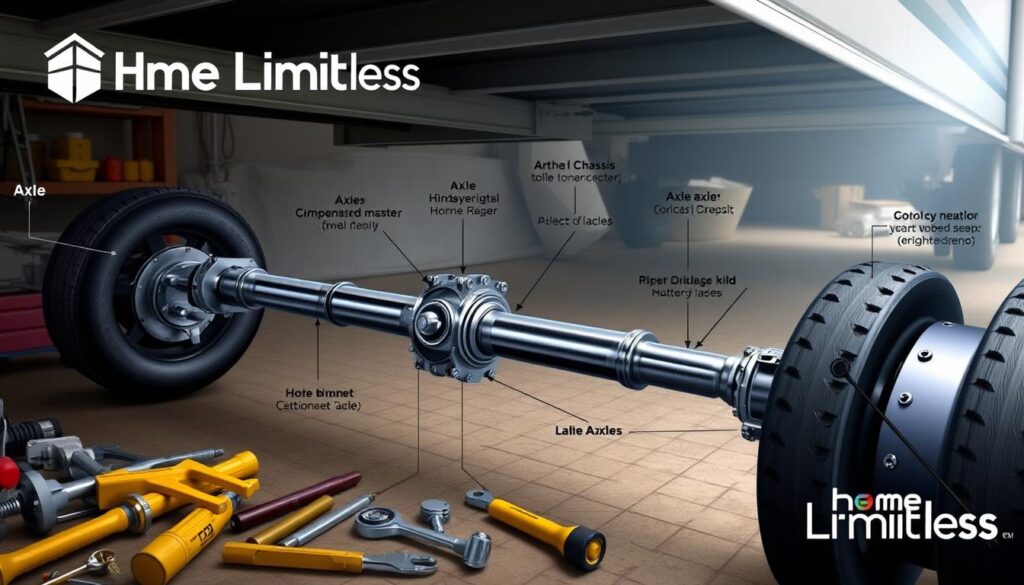
Key Features of Mobile Home Axles
Mobile home axles have unique features. They often have rim-clamp style hubs and 14.5-inch tires. These axles are strong and affordable, making them great for home-built and construction-site trailers.
Mobile vs Standard Axles
The main difference between mobile and standard axles is their width. Mobile home axles are often wider than the legal limit for trailers. Many are 104 inches or wider, which can lead to legal problems if not fixed.
| Feature | Mobile Home Axles | Standard Trailer Axles |
|---|---|---|
| Width | Often exceeds 102 inches | Typically within 102-inch limit |
| Cost | More affordable | Generally more expensive |
| Availability | Easily accessible | May require special ordering |
| Long-term use | Limited design for long-term use | Better suited for extended use |
Knowing these differences helps you make better choices when picking axles for your project. Always check the origin and details of your axles to ensure they’re good quality and follow the rules.
Tools and Materials Needed for Inspection and Replacement
Having the right tools and equipment is key for safe and efficient axle work. A good toolkit means you’re ready for any challenge.
Important tools include a floor jack, jack stands, and an impact driver or wrench. A breaker bar helps with tough bolts, and a torque wrench ensures bolts are tightened right. A mallet is useful for parts that won’t budge.
Remember to have grease for lubrication and wire cutters for brake wires. You’ll also need new parts for putting everything back together.
| Tool/Material | Purpose | Importance |
|---|---|---|
| Floor Jack | Lifting the mobile home | Critical for safety |
| Jack Stands | Supporting the lifted mobile home | Essential for stability |
| Impact Driver/Wrench | Removing and installing bolts | Speeds up the process |
| Torque Wrench | Precise bolt tightening | Ensures proper installation |
| Grease | Lubricating bearings | Reduces friction and wear |
With these tools and equipment, you’re set to handle axle work efficiently and safely.
Safety Precautions Before Starting
Before starting axle replacement, safety is a top priority. Taking the right steps can prevent accidents and make the process smoother. Here are the key safety measures to remember.
Proper Jacking and Support Techniques
When working on mobile home axles, support is crucial. Park your mobile home on level ground. Use sturdy jack stands to support its weight.
Never rely only on a jack, as it can fail and cause serious injury. Place the stands on solid ground, not on soft soil or asphalt that can give way under pressure.
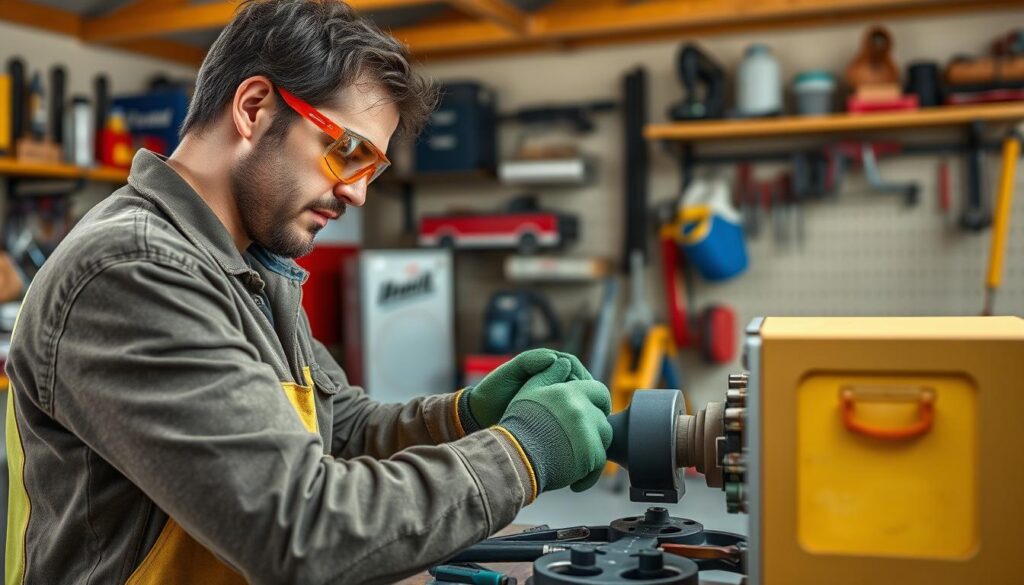
Personal Protective Equipment
Wearing the right gear is essential for trailer maintenance safety. Always use safety glasses to protect your eyes from debris. Sturdy work gloves shield your hands from sharp edges and hot surfaces.
Steel-toed boots offer protection if heavy parts fall. Don’t forget ear protection if you’ll be using power tools.
Workspace Considerations
A safe workspace is key for successful axle replacement. Ensure you have enough room to move around the mobile home comfortably. Good lighting is crucial – use work lights if natural light is insufficient.
Keep your work area clean and free of tripping hazards. Have a fire extinguisher nearby in case of emergencies. By following these precautions, you’ll create a safer environment for your DIY project.
Inspecting Mobile Home Axles
Checking your mobile home’s axles is key to keeping it safe and stable. First, look at the axle beam for rust, cracks, or bends. Also, check the welds and joints for damage, as these areas can wear out quickly.
Then, examine the hubs and bearings. Spin the wheels to see if they make any odd noises or feel stiff. Finding damage early can save you from expensive fixes later. Watch for uneven tire wear, which might mean the axles are bent or the alignment is off.
Next, inspect the brakes carefully. Look for worn-out brake shoes, damaged drums, or leaks in the brake fluid. Try the brakes by hand to see if they work right. If you find any problems, fix them fast to stay safe on the road.
Don’t skip checking the leaf springs and other suspension parts. Look for cracks, too much rust, or loose bolts. These parts are crucial for your mobile home’s stability and how smooth it rides.
- Check axle beam for rust, cracks, or bends
- Examine hubs and bearings for unusual noises
- Inspect brake components and test function
- Assess leaf springs and suspension parts
Remember, a detailed check of your axles can prevent sudden breakdowns and expensive fixes. If you’re not sure about anything, get a pro to check your mobile home’s axles. This way, you can be sure they’re in great shape.
Mobile Home Axles: Components and Their Functions
Mobile home axles are key for safe travel. Knowing their parts helps DIYers keep them in good shape. Let’s look at the main parts of these axles.
Axle Beam
The axle beam is the backbone. It’s a strong tube that goes across the mobile home. It carries the weight and links to other parts.
Hubs and Bearings
Hubs hold the bearings, which let wheels spin smoothly. Mobile homes often use Timken LM67048/LM670101 for outer and 25580/25520 for inner bearings.
Brakes and Brake Assemblies
Brake assemblies are key for stopping. Many mobile homes have 12″x2″ brake shoes, used in 6,000-7,000 lb axles. These parts help slow and stop the home while moving.
Suspension Components
Suspension parts like leaf springs and shackles soak up road bumps. They make the ride smoother and protect the home while it’s moving.
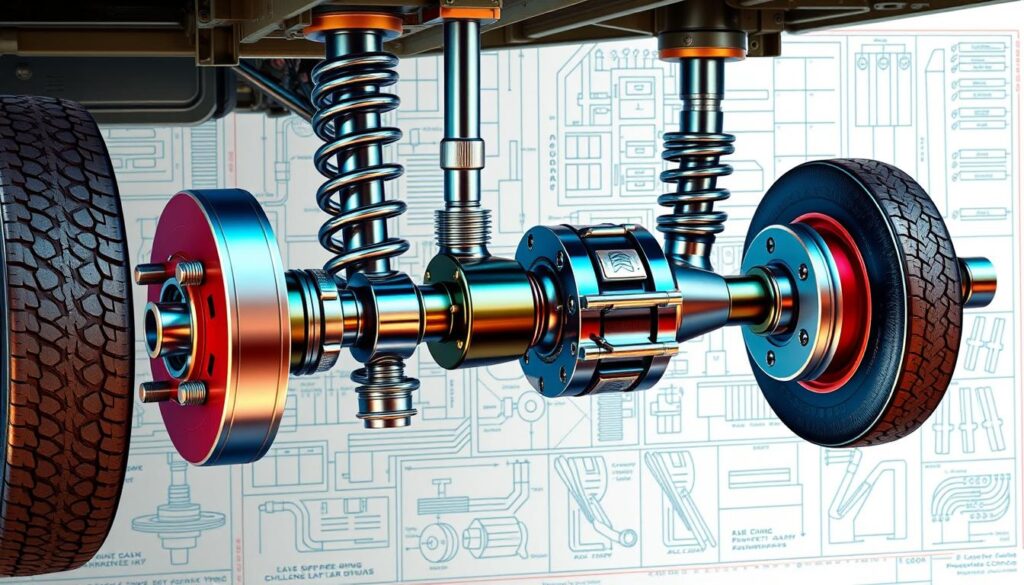
| Component | Function | Common Specification |
|---|---|---|
| Axle Beam | Main support structure | Cylindrical tube |
| Hubs | House bearings for wheel rotation | Specific bearing sizes |
| Brake Assemblies | Provide stopping power | 12″x2″ shoes |
| Suspension | Absorb road shocks | Leaf springs, shackles |
These axle parts work together for safe mobile home transport. Regular checks and upkeep can avoid problems and make your mobile home’s axle system last longer.
Step-by-Step Guide to Removing Old Axles
Removing old axles is key to replacing them. This guide will help you do it safely and efficiently.
First, jack up your trailer and use sturdy stands to hold it. Safety is crucial here. Take off the wheels and disconnect brake wires. Before removing bolts, support the axle.
Then, tackle the shackle bolts. These link the leaf springs to the axle. Remove them with a torque of 30-50 foot-pounds when putting them back. Grease the bolts for easier movement.
Next, remove the hanger bolts. These hold the leaf springs to the frame. After removing, lower the axle and slide it out from under the trailer. This finishes the main part of removing the axle.
- Jack up and secure the trailer
- Remove wheels and disconnect brake wires
- Remove shackle bolts
- Remove hanger bolts
- Lower and remove the axle
While removing, check all parts. This helps you see what needs to be replaced or can be reused. Remember, most trailers are 102″ wide, so choose axles that fit.
“Quality inspection during removal can save you from future headaches and unnecessary expenses.”
When reconnecting brake wires, use a scotch lock for splicing. Finally, when putting wheels back on, tighten lug nuts in a star pattern for even pressure.
Selecting the Right Replacement Axles
Choosing the right replacement axles for your mobile home is key for safety and performance. You need to think about several factors to make sure they fit and work well.
Load Capacity Considerations
When picking new axles, the load capacity is very important. The axles should be able to handle the same weight as the old ones. This keeps your mobile home safe and stable. Always check the specs and think about any changes that might add weight.
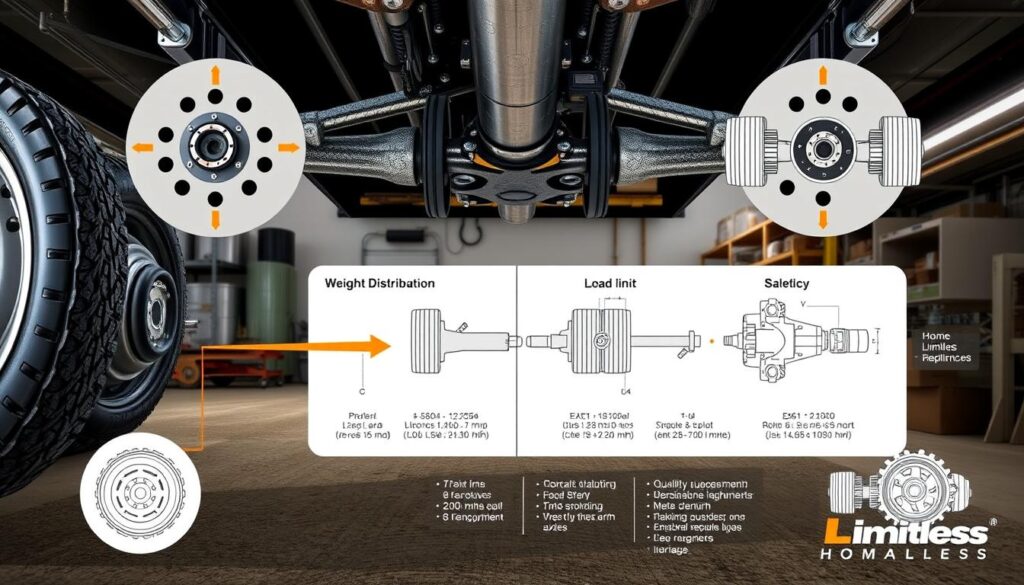
Compatibility with Existing Components
It’s important to choose axles that fit with your mobile home’s current setup. This includes the suspension, brakes, and frame. Measure everything carefully to make sure they fit right. This ensures they work well together and perform well.
New vs. Refurbished Options
You can choose between new or refurbished axles. New axles are reliable and often come with a warranty, but they cost more. Refurbished axles might save you money, but their quality and life span can vary. Think about your budget and future plans for your mobile home when deciding.
| Axle Type | Pros | Cons |
|---|---|---|
| New Axles | Reliable, warranty coverage | Higher cost |
| Refurbished Axles | Cost-effective | Variable condition, limited warranty |
Remember, keeping your axles well-maintained is crucial for their long life. Make sure to lubricate the bearings every year or every 12,000 miles. Always put safety first when choosing new axles.
Installing New Mobile Home Axles
The guide for installing mobile home axles is key for a smooth process. It needs precision and care to ensure safety and function. This is important for your mobile home’s well-being.
Begin by placing the new axle under the trailer, aligning it with the mounting points. Use a jack to raise the axle and secure it to the leaf springs and hangers. Tighten all bolts with a torque wrench, following the 30 to 50 ft-lbs range for shackle bolts.
Then, reconnect the brake wires and grease fittings. Install the wheels and tighten the lug nuts in a star pattern. This ensures even distribution. Finally, lower the trailer and do a detailed check and test.
When picking replacement parts, keep these points in mind:
| Part | Model | Price (CAD) |
|---|---|---|
| Outer bearing | Timken LM67048 | $8.65 |
| Outer race | Timken LM67010 | $4.19 |
| Inner Bearing | Timken 25580 | $18.10 |
| Inner race | Timken 25520 | $9.10 |
Remember, mobile home axle brake shoes are 12″x2″. They fit 6 and 7000lb conventional trailer axles. Proper installation and maintenance of axles, like gutters, are vital for your mobile home’s life and performance.
Conclusion
Learning DIY axle replacement is a great skill for mobile home owners. It’s a complex task but can be done with the right preparation and safety steps. Knowing the differences between manufactured, mobile, and modular homes is key for upkeep and financing.
Mobile home care goes beyond just the axles. It’s important to check foundations, roofs, and utilities regularly. If you’re thinking about moving, remember costs can vary a lot. The size of your home, the number of axles, and local rules all affect the cost.
Looking after your home, whether it’s small or large, is crucial for its long life. Modern manufactured homes are energy-efficient and can be customized. Staying up-to-date on maintenance and industry standards helps you get the most from your home.

